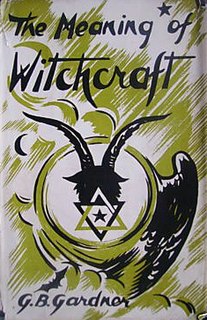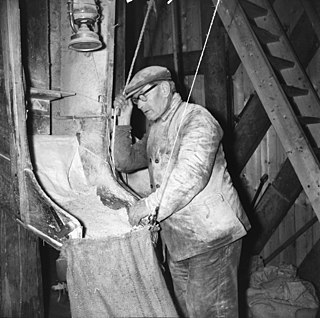
Gardnerian Wicca, or Gardnerian witchcraft, is a tradition in the neopagan religion of Wicca, whose members can trace initiatory descent from Gerald Gardner. The tradition is itself named after Gardner (1884–1964), a British civil servant and amateur scholar of magic. The term "Gardnerian" was probably coined by the founder of Cochranian Witchcraft, Robert Cochrane in the 1950s or 60s, who himself left that tradition to found his own.

Wicca, also termed Pagan Witchcraft, is a contemporary Pagan new religious movement. It was developed in England during the first half of the 20th century and was introduced to the public in 1954 by Gerald Gardner, a retired British civil servant. Wicca draws upon a diverse set of ancient pagan and 20th-century hermetic motifs for its theological structure and ritual practices.
Aradia is one of the principal figures in the American folklorist Charles Godfrey Leland's 1899 work Aradia, or the Gospel of the Witches, which he believed to be a genuine religious text used by a group of pagan witches in Tuscany, a claim that has subsequently been disputed by other folklorists and historians. In Leland's Gospel, Aradia is portrayed as a Messiah who was sent to Earth in order to teach the oppressed peasants how to perform witchcraft to use against the Roman Catholic Church and the upper classes.
Alexandrian Wicca or Alexandrian Witchcraft is a tradition of the Neopagan religion of Wicca, founded by Alex Sanders who, with his wife Maxine Sanders, established the tradition in the United Kingdom in the 1960s. Alexandrian Wicca is similar in many ways to Gardnerian Wicca, and receives regular mention in books on Wicca as one of the religion's most widely recognized traditions.
Ronald Hutton is an English historian who specialises in the study of Early Modern Britain, British folklore, pre-Christian religion and contemporary Paganism. A professor in the subject at the University of Bristol, Hutton has published fourteen books and has appeared on British television and radio. He has held a fellowship at Magdalen College, Oxford and is a Commissioner of English Heritage.

Edith Rose Woodford-Grimes (1887–1975) was an English Wiccan who achieved recognition as one of the faith's earliest known adherents. She had been a member of the New Forest coven which met during the late 1930s and early 1940s, and through this became a friend and working partner of Gerald Gardner, who would go on to found the Gardnerian tradition with her help. Widely known under the nickname of Dafo, Woodford-Grimes' involvement in the Craft had largely been kept a secret until it was revealed in the late 1990s, and her role in the history of Wicca was subsequently investigated by historians.
The Horseman's Word, also known as the Society of Horsemen, is a fraternal secret society operating in Britain for those who work with horses. Established in north-eastern Scotland during the early nineteenth century, in ensuing decades it spread both to other parts of Scotland and south into Eastern England. Although having largely declined by the mid-twentieth century, the society continues to exist in a diminished capacity within parts of Scotland.
The history of Wicca documents the rise of the Neopagan religion of Wicca and related witchcraft-based Neopagan religions. Wicca originated in the early twentieth century, when it developed amongst secretive covens in England who were basing their religious beliefs and practices upon what they read of the historical Witch-Cult in the works of such writers as Margaret Murray. It was subsequently popularised in the 1950s by a number of figures, in particular Gerald Gardner, who claimed to have been initiated into the Craft – as Wicca is often known – by the New Forest coven in 1939. Gardner's form of Wicca, the Gardnerian tradition, was spread by both him and his followers like the High Priestesses Doreen Valiente, Patricia Crowther and Eleanor Bone into other parts of the British Isles, and also into other, predominantly English-speaking, countries across the world. In the 1960s, new figures arose in Britain who popularised their own forms of the religion, including Robert Cochrane, Sybil Leek and Alex Sanders, and organisations began to be formed to propagate it, such as the Witchcraft Research Association. It was during this decade that the faith was transported to the United States, where it was further adapted into new traditions such as Feri, 1734 and Dianic Wicca in the ensuing decades, and where organisations such as the Covenant of the Goddess were formed.

Wiccan morality is largely expressed in the Wiccan Rede: 'An' it harm none, do what ye will' - old-fashioned language for 'as long as you aren't harming anyone, do as you wish'. While this could be interpreted to mean "do no harm at all," it is usually interpreted as a declaration of the freedom to act, along with the necessity of thinking through and taking responsibility for the consequences of one's actions.

The Museum of Witchcraft and Magic, formerly known as the Museum of Witchcraft, is a museum dedicated to European witchcraft and magic located in the village of Boscastle in Cornwall, south-west England. It houses exhibits devoted to folk magic, ceremonial magic, Freemasonry, and Wicca, with its collection of such objects having been described as the largest in the world.

Vivianne Crowley is an author, university lecturer, psychologist, and a High Priestess and teacher of the Wiccan religion. She was initiated into the London coven of Alex Sanders at the age of eighteen, but later joined a Gardnerian coven in the famous Whitecroft line derived from Eleanor Bone, and so she was one of few people in the seventies to be part of both traditions.

The Neo-pagan movement in the United Kingdom is primarily represented by Wicca and Witchcraft religions, Druidry, and Heathenry. According to the 2011 UK Census, there are roughly 53,172 people who identify as Pagan in England, and 3,448 in Wales, as well as 11,026 Wiccans in England and 740 in Wales.

The witch-cult hypothesis is a discredited theory which proposes that the witch trials of the Early Modern period were an attempt to suppress a pre-Christian, pagan religion that had survived the Christianisation of Europe. According to its proponents, this witch-cult revolved around the worship of a Horned God of fertility whom the Christian persecutors referred to as the Devil, and whose members participated in nocturnal rites at the witches' Sabbath in which they venerated this deity.

The Meaning of Witchcraft is a non-fiction book written by Gerald Gardner. Gardner, known to many in the modern sense as the "Father of Wicca", based the book around his experiences with the religion of Wicca and the New Forest Coven. It was first published in 1959, only after the British Parliament repealed the Witchcraft Act of 1735, and proved to be Gardner's final book. The Wicca religion as expounded by Gardner was focused on a goddess, identified with the night sky and with wild nature, and a horned god who represented the fertilizing powers of the natural world. It was organized into covens, through which members were initiated through three ascending degrees of competence and authority and which were governed by a high priestess, supported by a high priest. More historical context to the pagan practice of Wicca can be found in the book Wicca: History, Belief, and Community in Modern Pagan Witchcraft That book discusses Wiccan life, covering how and why people convert to Wicca; its denominations; its sociological demographics; its political beliefs, particularly in terms of environmentalist issues; the impact of anti-Wiccan persecution; the transmission of Wiccan and Pagan culture; and the history of academic analysis of Wicca.
Traditional witchcraft is a term used to refer to a variety of contemporary forms of witchcraft. Pagan studies scholar Ethan Doyle White described it as "a broad movement of aligned magico-religious groups who reject any relation to Gardnerianism and the wider Wiccan movement, claiming older, more "traditional" roots. Although typically united by a shared aesthetic rooted in European folklore, the Traditional Craft contains within its ranks a rich and varied array of occult groups, from those who follow a contemporary Pagan path that is suspiciously similar to Wicca to those who adhere to Luciferianism".

The Pagan Religions of the Ancient British Isles: Their Nature and Legacy is a book of religious history and archaeology written by the English historian Ronald Hutton, first published by Blackwell in 1991. It was the first published synthesis of the entirety of pre-Christian religion in the British Isles, dealing with the subject during the Palaeolithic, Neolithic, Bronze Age, Iron Age, Roman occupation and Anglo-Saxon period. It then proceeds to make a brief examination of their influence on folklore and contemporary Paganism.

The Triumph of the Moon: A History of Modern Pagan Witchcraft is a book of religious history by the English historian Ronald Hutton, first published by Oxford University Press in 1999. At the time, Hutton was a Reader in History at Bristol University, and had previously published a study of ancient pre-Christian religion, The Pagan Religions of the Ancient British Isles (1991) as well as studies of British folk customs and the Early Modern period.
Quest is an esoteric quarterly magazine containing material on magic, witchcraft, and practical occultism, along with personal experiences and reviews. It has been edited since its inception in 1970 by the author Marian Green, who also organises an associated annual Quest Conference.
The Cauldron is a non-profit-making, independent, esoteric magazine featuring serious and in-depth articles on traditional witchcraft, Wicca, ancient and modern paganism, magic and folklore. It has been published quarterly in the UK in February, May, August and November since 1976. It was founded to cater for pagan witches, giving space in particular to non-Gardnerian traditions of witchcraft and so provided some balance to The Wiccan, the mouthpiece of the Pagan Front. The Cauldron has been edited since its inception by Michael Howard who "has been active among pagans and ritual magicians since the early 1960s".
Eric Maple (1916–1994) was an English folklorist and author known for his studies of witchcraft and folk magic in late nineteenth and early twentieth-century Essex, in particular his first-hand research into the folklore surrounding the cunning men James Murrell and George Pickingill.












